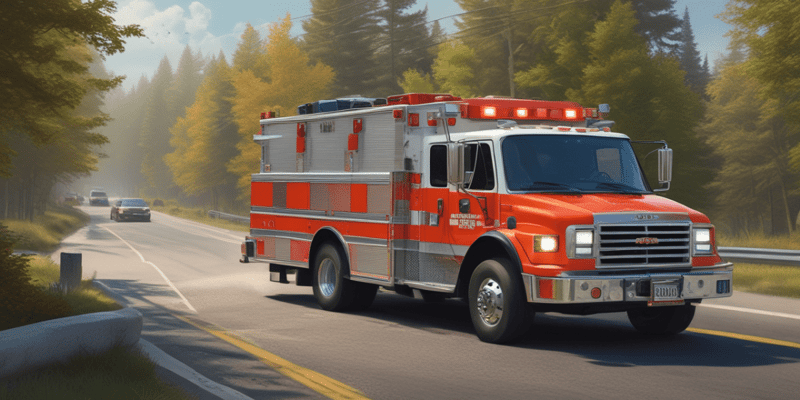Podcast Beta
Questions and Answers
What must be checked during the daily inspection of the SCBA?
How often should SCBA be inspected according to guidelines?
What should be done if a malfunction is found during an inspection?
What is the minimum acceptable pressure for in-service cylinders?
Signup and view all the answers
Which of the following components is NOT required in SCBA inspections?
Signup and view all the answers
What should be ensured regarding the regulator during inspections?
Signup and view all the answers
What activation point should be checked for the end-of-service-time-indicator?
Signup and view all the answers
Which is a requirement for remote gauge checks during the inspection?
Signup and view all the answers
What should be inspected on the face piece besides the lens?
Signup and view all the answers
What is the correct way to ensure a proper connection to the SCBA cylinder?
Signup and view all the answers
Which component should you check for proper functionality on the harness assembly?
Signup and view all the answers
What does the low battery condition indicate for the PASS device?
Signup and view all the answers
How should you manually activate the full alarm on the PASS device?
Signup and view all the answers
What should you do if the back-frame module chirps every two seconds?
Signup and view all the answers
What is indicated by the flashing LOW BATTERY indicator on the HEADSUP display?
Signup and view all the answers
What must be done if the regulator fails during inspection?
Signup and view all the answers
What is the primary responsibility of the Spring Fire Department regarding respiratory equipment?
Signup and view all the answers
When must a member breathe air from an SCBA?
Signup and view all the answers
What happens to the air supply duration of SCBA units during emergency conditions?
Signup and view all the answers
What is not allowed to be worn while using an SCBA?
Signup and view all the answers
What component of the breathing apparatus must be functioning properly?
Signup and view all the answers
How should eyeglass users fit their glasses when using an SCBA?
Signup and view all the answers
Who is responsible for ensuring the use of SCBA when necessary?
Signup and view all the answers
What must be considered when making repairs or updates to SCBA units?
Signup and view all the answers
What should be done to the cylinder valve after cleaning?
Signup and view all the answers
Which method should NOT be used to clean any part of the Scott Airpak?
Signup and view all the answers
What is crucial to inspect on the facemask before putting it back into service?
Signup and view all the answers
How should SCBA cylinders be stored?
Signup and view all the answers
What must be done to SCBA cylinders that have stored compressed air for over 12 months?
Signup and view all the answers
In what situation can potentially soiled SCBA equipment be exposed to the public?
Signup and view all the answers
Who is responsible for ensuring annual testing of SCBA assemblies and Face Pieces?
Signup and view all the answers
What cleaning agent is acceptable for sanitizing the facemask?
Signup and view all the answers
Who is responsible for maintaining records of the SCBA testing?
Signup and view all the answers
What will happen if an SCBA or component shows signs of failure?
Signup and view all the answers
Which organization must be informed about SCBA failures?
Signup and view all the answers
Who is responsible for the repair and maintenance of all Equipment/Respirators?
Signup and view all the answers
What must SCBA technicians maintain in order to perform repairs?
Signup and view all the answers
What is the minimum time records of testing need to be maintained?
Signup and view all the answers
What documentation may be provided to the SCBA manufacturer in case of failure?
Signup and view all the answers
What is the role of the members from the Quartermaster Department?
Signup and view all the answers
Study Notes
Respiratory Protection Program
- Spring Fire Department will purchase only NFPA compliant respiratory equipment.
- The latest NFPA standard in effect at the time of purchase or rebuild applies to all respiratory equipment.
- All SCBA units must meet the current standard at the time of repairs or updates.
- SCBA units provide a 45-minute air supply.
- SCBA units must comply with NFPA 1981.
- SCBA units are required in IDLH atmospheres.
- SCBA units must be used from initial attack to the end of overhaul.
- SCBA units must have a functioning PASS device.
- Eyeglass straps or temple bars cannot pass between the face piece seal and face.
- Glasses must be fitted inside the face piece.
- Soft contact lenses can be worn if they have had long-term use.
- Hard contact lenses are prohibited.
- No headcovering can pass between the face piece seal and face.
- Facial hair must adhere to SFD.055 Uniform and Grooming Guideline.
- SCBA face piece straps cannot be worn over protective hoods.
Inspection of Respiratory Equipment
- Daily inspections are required at the start of each tour of duty.
- Weekly inspections are required on each apparatus day.
- Inspections are also required after each use on a scene or in training.
- All SCBA units should be inspected within one week per NFPA 1852.
- Malfunctioning or damaged units must be removed from service and tagged "Out of Service."
- Units must be written up on PSTRAX to notify the SCBA repair technicians.
Components of SCBA units
- Facepiece
- Back Frame and Harness assembly
- Cylinder
- Hose
- End-of-service-time-indicator (Vibe alert)
- Regulators
- Accessories
SCBA Components and Operation Inspection
- Cylinder pressure gauge should read full (4500 psi).
- Replace the cylinder or recharge if below 4500 psi.
- In-service cylinders should not fall below 90% (4000 psi).
- Open cylinder completely to ensure proper operation.
- Check bypass valve to ensure proper operation.
- Doffing switch should stop the flow through the regulator.
- Regulator gasket should be present and free from cracks and gouges.
- Regulator should click and secure to mask, and not be able to free spin.
- End-of-service-time-indicator should activate at 25% cylinder pressure.
- Integrated PASS device should activate.
- Remote gauge and cylinder pressure should deviate no more than 10%.
- Ensure straps and harnesses are in good condition and fully extended.
Facepiece Inspection
- Inspect frame for damaged components, deterioration, cracks, tears and holes.
- Inspect head-harness buckles, straps and webbing for functionality.
- Inspect the lens for scratches, abrasions, and heat damage.
- Inspect voice amplifier for proper operation.
SCBA Frame and Cylinder Inspection
- Inspect back plate and harness assembly for damage.
- Inspect all hoses for damage.
- Confirm that low-pressure (Vibe Alert) alarm and Integrated PASS are functioning properly.
- Inspect all gauges for proper reading and damage.
- Inspect the regulator for proper operation of controls and bypass valve.
- Inspect cylinder for current hydrostatic date, ensure date is no more than 5 years old.
- Check seal in high pressure hose to cylinder connector, thread damage, and proper connection to the cylinder.
- Visually inspect cylinder for dents, gouges, cuts, discolored paint, charred decals, melted gauge lens, or distorted bumper.
Integrated Personal Alert Safety System (PASS) Inspection
- Ensure the PASS enters pre-alert phase.
- Ensure pre-alert is shut off by motion.
- Allow PASS to enter full alarm.
- Ensure PASS alarm reset button shuts off the alarm.
- Ensure manual alarm button activates full alarm.
- Check for low battery indication.
Cleaning of SCBA
- Cylinder valve should be cracked open to blow out any moisture.
- Thoroughly clean the frame, straps and harness in accordance to the manufacturer's recommendations.
- Use warm soapy water, a sponge, and a soft-bristled brush.
- Avoid applying water directly to electronics.
- Do not use bleach.
Cleaning of Facemask
- Remove the facemask from the low-pressure regulator.
- Remove the VoiceAmp, if present.
- Wipe the exterior surfaces with a cloth and warm soapy water.
- Use a soft-bristled brush and soap to clean any dirt, grime, or debris.
- Rinse with a low-pressure water stream.
- Allow to air dry.
- Inspect for cracks, leaks, and proper seal before returning to service.
Storage of SCBA
- Store all in-service SCBA cylinders fully charged.
- Store apparatus mounted SCBA in a secure compartment or NFPA approved cylinder storage device.
- Purge and refill cylinders if compressed breathing air has been stored for over 12 months.
- Decontaminate contaminated SCBA prior to storage in the apparatus.
- Never wear or bring SCBA into living quarters.
- Do not expose the public to contaminated SCBA unless during emergency operations.
Annual SCBA Inspection and Testing
- All SCBA assemblies and face pieces must undergo annual full-function testing by a factory authorized service provider in accordance with NFPA 1852.
- Maintain testing records for a minimum of 3 years.
- Remove any failing, near failing, or significantly degraded items from service and tag them "for repair- do not use."
- Notify the Deputy Chief of Support Services and the manufacturer of any failing components.
- Provide the manufacturer with prior data logs, video, or photos of the condition.
- Copy notifications shall be sent to the Texas Commission on Fire Protection, NIOSH, and NPPTL.
- Ensure cascade systems are inspected, tested, maintained, and documented in accordance with NFPA 1989.
SCBA Maintenance
- Maintenance and repairs must be done by a specially trained person(s) with parts designed for the equipment/respirators.
- Do not replace or repair components beyond the manufacturer's recommendations.
- The Spring Fire Department SCBA Shop Manager / Personnel will be responsible for the repair and maintenance of all equipment/respirators.
- Members from the Quartermaster Department will be sent to the SCBA Technician Course with authorization from the manufacturer.
- Only certified and qualified members from the Quartermaster Department are authorized to make manufacturer approved repairs, alterations, maintenance, and testing.
Studying That Suits You
Use AI to generate personalized quizzes and flashcards to suit your learning preferences.
Related Documents
Description
This quiz covers the key aspects of the Spring Fire Department's NFPA compliant respiratory equipment program. Participants will learn about SCBA unit requirements, maintenance standards, and safety protocols regarding face piece fittings and grooming guidelines. Understanding these standards is crucial for ensuring safety in hazardous environments.




